Irkallian Oracle
2016-05-17
by Niklas Göransson
A thorough excavation in and around the shrine of faceless Swedish death/black congregation Irkallian Oracle; join us as we debate the merits of magic, metal and reality itself.
This article can also be found in Bardo Archivology Vol. 1, a printed anthology with selected features from the online archive. Additional content includes AOSOTH, NIFELHEIM, UNPURE, MORBID, ABIGOR, NUMINOUS, CLANDESTINE BLAZE, RIDE FOR REVENGE, AKITSA, MALIGN, NORDVIS, ARMAGEDDA, EHLDER, and DEATHSPELL OMEGA – all presented in ambitious aesthetics with plenty of custom artwork. More information here.
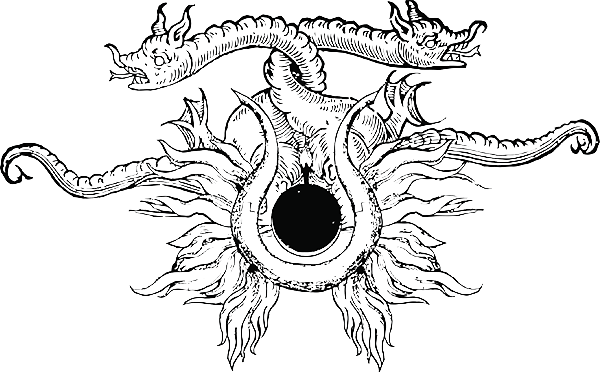
Meet the ambassador of IRKALLIAN ORACLE, orator in music as well as media. Seeing as how they have no official line-up and wish to remain anonymous, that’s about as much as I’m at liberty to say. The Gothenburg based band presents itself as a singular entity rather than an ensemble of individuals. This appears to be in line with the very nature of the seer; taking Pythia as an example, the Oracle of Delphi, where it’s not the priestess herself that is the source of the revelations but merely its voice.
– Exactly. Although we are in effect a musical group consisting of several personalities, what really matters is the choir of our collective voice. In that sense, the oracle itself is only one and not a multitude – though at the same time no more relevant than any single participant, being nothing but a mouthpiece for something far greater.
He describes how the word ‘oracle’ immediately came to mind when it was time to christen the project. They wanted something mediumistic or prophetic, signifying the craftsmanship of binding worlds above and below with threads spun from sound and linguistics.
– A vision of something utterly alien communicating through the veil, a divine voice ringing out into the formulated world from beyond the shroud of illusion. In that sense, it has a lot to do with influence; the work of transcribing something highly abstract into noise and letters. It’s a matter of taking a step back from contemporary cults of anthropocentrism – the belief that everything revolves around the human being – and shifting focus to the art itself, not its superficial aspects.
IRKALLIAN ORACLE’s most recent contribution to this tradition is their second album, “Apollyon”, released by Nuclear War Now! Productions in February 2016. The production is a strange but ultimately fitting affair, shrouded in a muddled dissonance that makes the slower droning parts sound more like something from the ritual ambient genre than a metal album.
– It was recorded in the legendary Gothenburg studio Nacksving – previously used by bands such as NIFELHEIM and BESTIAL MOCKERY – then mixed and mastered by VK of VASSAFOR. We set out to forge something a bit more dynamic and thought-through than the production on our 2013 debut, “Grave Ekstasis”, which was quite simplistic and spontaneous. This time we wanted a sound exhibiting force and clarity, as dark as the music. The end result was even darker than predicted, in an auditory rather than metaphysical sense, as the mix could’ve done with a bit more pronounced guitars and less low-end bass. However, the final result is both unique and fitting so no need to dwell on that.
The closing track, “At the Graveyard of Gods” – besides having a nice BESTIAL WARLUST reference in the title also has a strange outro.
– It’s actually acoustical pressure waves from the sun, picked up by a SOHO spacecraft.
Another unique feature is the rather peculiar use of percussion, such as the tambourines and bells in “Apollyonic Enstasis”. Inspiration stems from various kinds of shamanic drumming, the purpose being to induce associated mental states and dragging us, the listeners, into the birthplace of the music we’re communing with.
– I truly believe that if you invest work and power into a piece of art – “Apollyon” in this case, obviously – it will somehow shine through in the end and take on life of its own, an image imbued with a spirit that speaks by itself. To this purpose, the instruments we used were all ritually charged sonic talismans specifically consecrated for use on this album.
Can you elaborate on the ‘ritually charged’ part?
– Alright; specific genii were asked to possess them, they were sanctified with various types of material collected on specific dates and adorned with signs revealed in visions. They were aligned to the intent of the recording and then buried at suitable sites for a number of nights. Granted, I’m not sure if any of this can actually be heard on the record but it can certainly be felt.
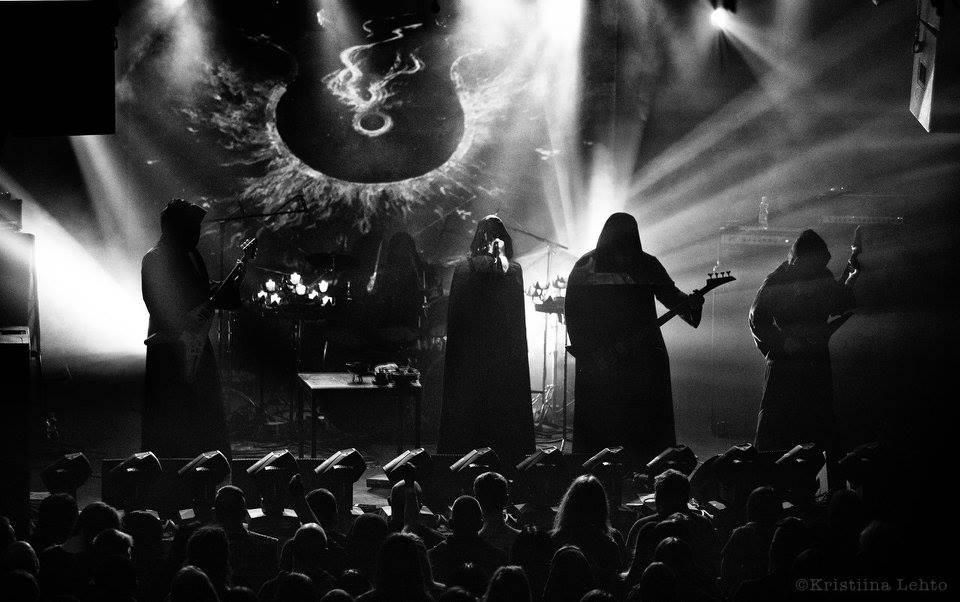
Some consider Australian PORTAL to be pioneers of this niche that’s currently enjoying some popularity; playing murky death/black metal with occult lyrics in lofty prose while the anonymous members appear in flamboyant disguises. IRKALLIAN ORACLE is one party that’s been implicated in these discussions.
– Sure, I suppose it’s unavoidable if people can’t see past superficial aspects. We’re equally influenced by other bands but it would be absurd of us to deny having drawn inspiration from PORTAL when we started, although probably more so by IMPETUOUS RITUAL. Some of our first supporters back when we recorded “Grave Ekstasis” came from the Queensland scene, so in that sense we feel a companionship of sorts with them.
Like many of their hooded peers, IRKALLIAN ORACLE’s live performances feature ceremonial attributes such as altars, candles, incense, and members in alleged trance states. I’ve seen a fair few bands do this now and often find myself pondering how much of the staggering about is melodramatic prancing rather than ritualised rapture.
– Who defines where ‘real’ ritual ends and theatrics begin? It’s difficult to separate one from the other; it might simply come down to intent. See the Catholic Eucharistic mass, the dance of Loa spirits in Voodoo, or the initiations through the freemasonry grades as examples of ‘real’ rituals with a theatrical dimension. Perhaps ceremonial worship is simply a type of play in which the leading characters are performed by gods or spirits? I view our performances as public rituals open for anyone to attend and, to a certain degree, partake in. It’s about creating a suitable atmosphere where the music can be expressed and experienced in the most appropriate manner possible. To create something infinitely powerful – allowing spectator and spectacle alike to summon, concentrate, and channel sufficient energy to venerate the daemon of music and arts.
And what does this accomplish?
– When utilised the right way then great, wonderful, and terrible things may emerge – it’s in such company you’ll find the best way to embrace our work. IRKALLIAN ORACLE functions on multiple levels; it’s a sensual and mental experience capable of prying open the participant’s mind to a much higher degree than it would by merely listening at home.
Another source of curiosity whilst watching on-stage rituals is ofttimes whether I’m witnessing something only performed under the spotlight, if such rites are also conducted when there’s no one there to see.
– I carry out lesser forms of religious rituals every day, then a few more advanced ones along the week. This ranges from meditation and prayer to lesser forms of theurgy and invocation further to more elaborate practices, in solitary as well as group settings.
Meditation – that’s something I find very strange that so few metal occultists appear to have even dabbled with.
– I’ve practiced various types of meditation just about every day for the last thirteen years. Where the hell did you get the idea that occultists don’t meditate?
Hold, I specified ‘metal’ occultists – I wasn’t talking about esoteric practitioners in general. I’ve tried asking quite a few people who play in bands using arcane imagery and lyrics and the usual answer tends to be along the lines of, ‘Playing music is my meditation.’ And, ‘I slip into a trance state on stage.’
– At least to me, all form of ‘occult’ work is so entrenched in meditative states and prayer that it’s not even possible to separate one from the other. Our lyrics deal more with meditation and the mystical experience than ‘magic’ as such but, then again, one thing doesn’t necessarily exclude the other.
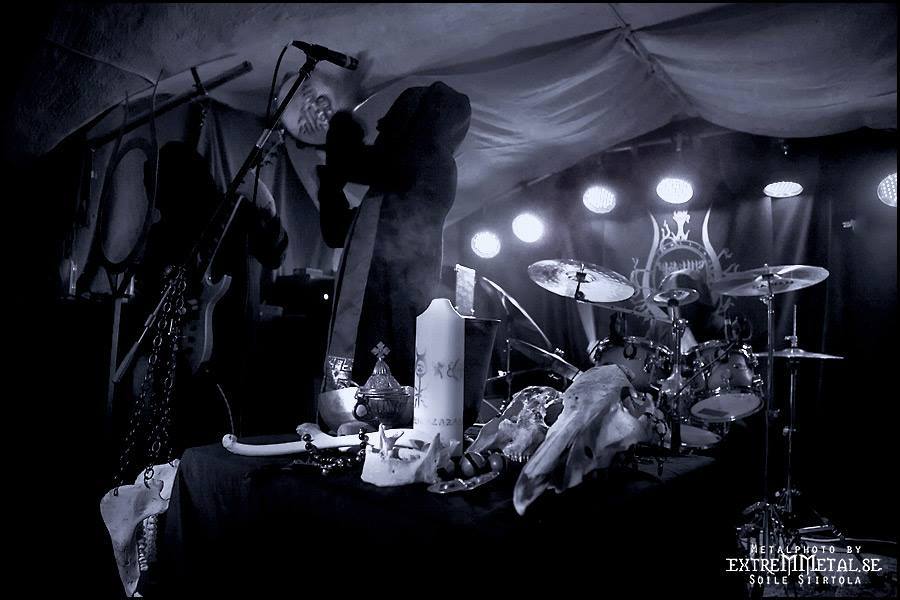
It might not be the focal point but magical work is unquestionably a prevalent factor in IRKALLIAN ORACLE. Judging from aesthetics alone – the dark robes and so forth – one would have to assume that there’s some manner of ‘black magic’ at play.
– Now we’re moving into technical territory. Traditionally, black magic is thought to be performed with a stated goal of fulfilling material needs. Using that sweeping definition, all types of folk magic are ‘black’ whereas the more scholarly and clerical schools are construed as ‘white’.
He explains that these categorisations are usually concurrent with the powers being sought. Those who call upon infernal spirits or demons perform ‘black’ magic whereas seeking the aid of saints, angels or even spirits connected to the zodiac and planets would fall under the ‘white’ label.
– Aleister Crowley proposed that black magic was simply ‘the use of spiritual force to material ends’, as opposed to wholly aligned with one’s higher self or will. If we were to label it as simply being in contact with ‘infernal’ or shunned spiritual forces, then yes – I do practice black magic. Using Crowley’s definition however, certainly not. It’s not that I see any moral complications with black magic, there’s just little reason to pursue it with much diligence unless basic carnal rewards rank among one’s prime ambitions in life. There are far more efficient ways to toy with your ego than practicing such elaborate things as magic; significantly safer ones at that.
Does this carry with it any risks then?
– Without proper training and performed under the wrong circumstances, it can most certainly be dangerous to your sanity. There are obviously levels to this, it’s a complex issue and depends heavily on the practitioner’s mental state as well as the nature of the forces being employed. Working with these things, you open doorways in your mind that are usually shut and some of the things you might find in there aren’t pretty.
I find it somewhat odd that during all my years of fraternising in milieus allegedly rife with adventurers of the arcane, I have yet to hear of a single one subjected to anything remotely like a ‘bad trip’ from conjuration complications.
– They’re either not telling you about it or have basically not been doing things right. See, if you’ve never been scared out of your fucking mind by practicing magic – well, then you haven’t practiced magic.
He adds that a terrifying experience doesn’t necessarily mean it was unproductive, quite the opposite. This could be likened with ritualistic use of psychoactive plant sacraments where, in retrospect, the challenging journeys are often considered most beneficial.
– I don’t mean to sound ominous or as if I’m encouraging imprudence but if you’re not taking any risks, if you resist the art from tearing asunder the fabric of your reality, then you’ve forfeited the reasons for doing it in the first place. These exercises are meant to completely change the practitioner and the only way that will ever happen is if he or she is put in a position of genuine spiritual peril. There are mature ways of facilitating situations like that, just as there are ones which are downright stupid. It’s not a matter of being reckless or disrespectful to your well-being, it’s remaining aware how magic is something which will always demand something from you in return. If you’re not prepared for that, well – you’re likely to end up with a few nasty surprises. In this sense, the main problem with magic isn’t that it doesn’t work but rather that it works all too well.
These trials bring to mind archaic rites of passage such as the Eleusinian Mysteries in Ancient Greece, where the cult of Demeter – goddess of agriculture and fertility – made facing one’s fears and mortality into their quintessential initiatory ceremony.
– I’m aware of them but hardly an expert; since they were carried out for almost two-thousand years it must’ve been a highly complex religious practice resting on a profoundly philosophical foundation. From what I remember, there are essential aspects that remain unknown to scholars due to the oath of secrecy sworn by its participants. It would be impossible to reconstruct something like that, bearing also in mind how different our contextual framework is from the practitioners of old. However, the notions of that age are the same as one might deal with today: death and rebirth, descent and ascent, love, loss and sacrifice, maternity, seasonal changes, and so forth. Universal concepts which still speak to us today and that can be enacted and experienced through contemporary mystical rites, still granting us insight into our own reality.
There is little doubt that IRKALLIAN ORACLE fully espouse the ‘black’ and ‘death’ part of their genre and, judging by the garments of the gentleman I’m conversing with, there seems to be an equally strong bond to metal. Even though we’re used to it now, a subculture with an inherent outlaw mind-set and a rebellious penchant for chaos doesn’t sound like the obvious choice for those who herald crafts demanding tranquillity, concentration, stillness of mind, and self-discipline.
– We have somewhat of an ambivalent relationship with metal. Basically, metal is fucking stupid but, then again, it’s the banality that makes it so appealing. Metal, at its best, is an equivalent to the raw power and arrogance of the subversive promethean spirit. Great depth can be found in its anti-intellectualised simplicity, an art-form that wears its heart on its sleeve. More often than not though, it’s just a nightmare of poor taste – a haven for bullied farm-boys and a clear indication that Western culture has finally hit rock bottom.
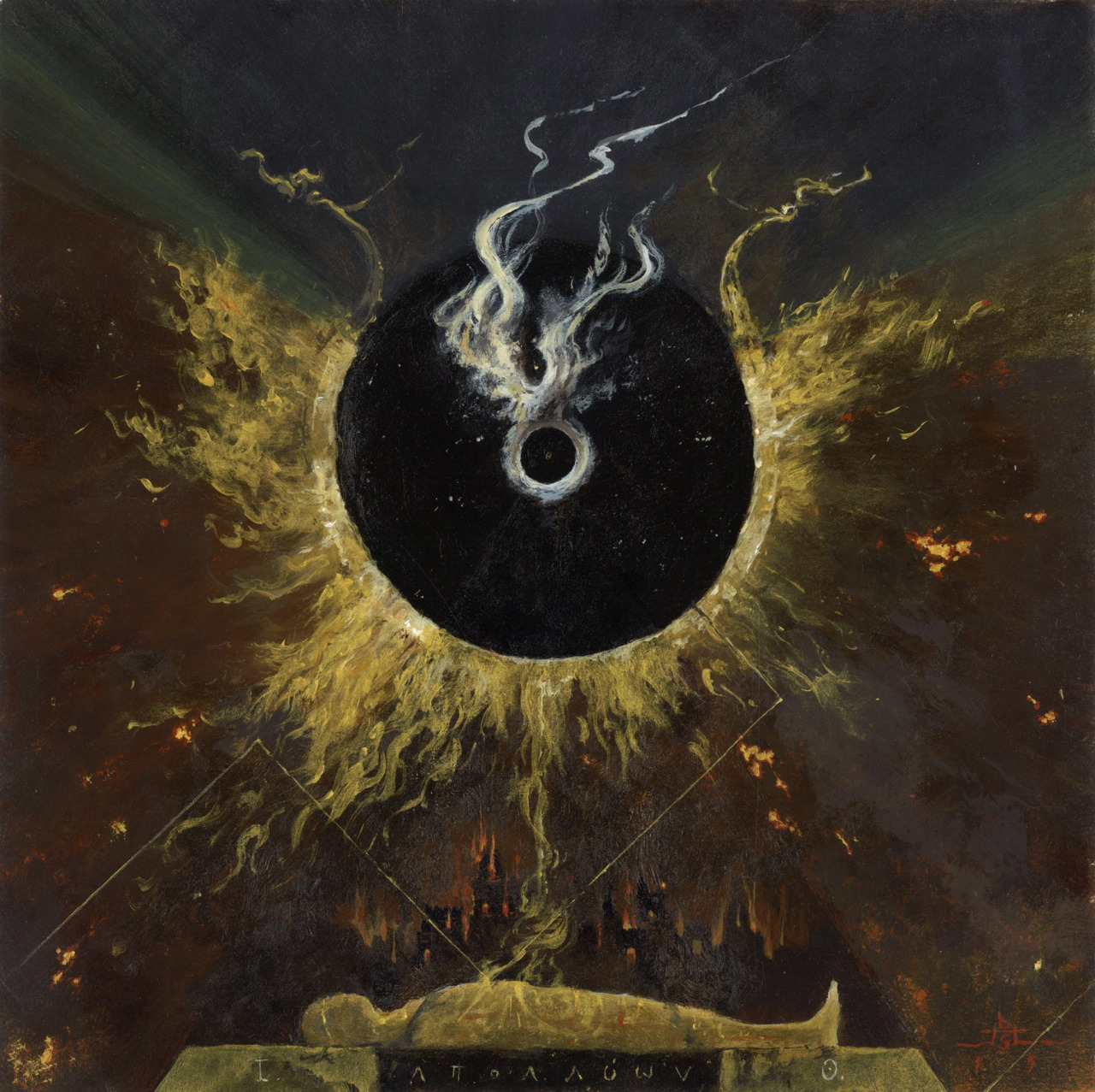
The rather striking cover artwork for “Apollyon” was made by Gothenburg based but Mexican born esoteric artist David Herrerias of art collective Graphic-noise.
– He did a great job with it. At the base lies a mummified corpse going through the alchemical process of nigredo, or ‘blackening’ – a state where one is cleansed of emotion and thoughts, purged of the chaotic impurities constituting our regular state of consciousness. In order to face our true selves, the constant cerebral movement caused by our fleeting and ever-changing mental reality must be stilled. One must rid oneself of that which seemingly makes up what we think of as ‘ourselves’, cognitive structures reflecting the images of worlds within and without. Something very strange happens in this state of oblivion, once we’ve undergone full deconstruction. We’re faced with a fresh reality once we encounter our true selves in the first light of the new dawn, as symbolised by the black sun rising over the cadaver’s solar plexus. Then there’s the burning city in the background, below the eclipse, which has to do with the mystical experience always taking a rather macrocosmic character. What that means? I’ll leave that up to your readers to decide.
Now quoting Metal Archives; ‘In Babylonian mythology, Irkalla is the underworld from which there is no return’.
– When embarking on this path and realising how perilous it is, you’ll either promptly turn back or see it through ‘til the end – for better or worse. I imagine the first option lies well beyond my grasp nowadays, if there ever was one to begin with. Dealing with things like this, you’ll soon be left wondering if the choice was ever your own or if there were other forces at play. On the other hand, there’s always a ‘return’ in a sense yet one’s outlook has changed so much that it’s impossible to look upon things the same way as before. The surroundings might not have changed but your perspective certainly has, and by that the world is cast in a completely new light.
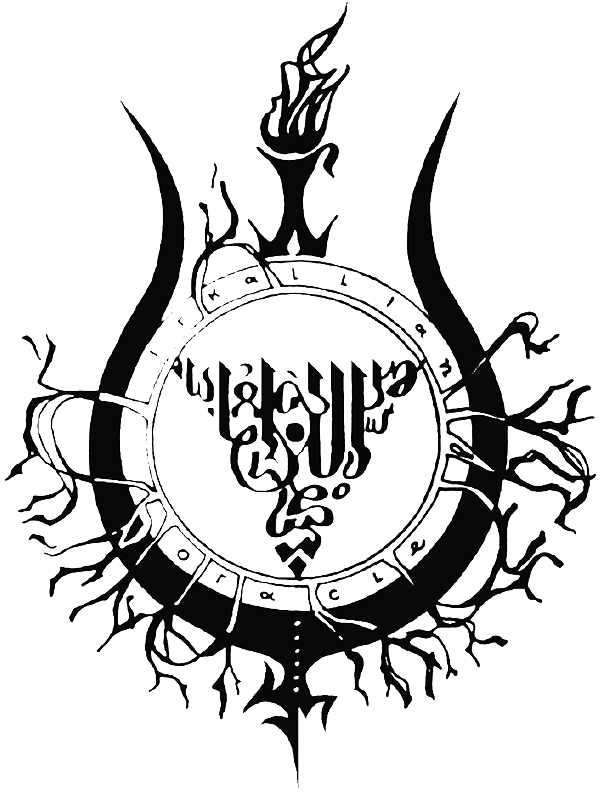
This article can also be found in Bardo Archivology Vol. 1, a printed anthology with selected features from the online archive. Additional content includes AOSOTH, NIFELHEIM, UNPURE, MORBID, ABIGOR, NUMINOUS, CLANDESTINE BLAZE, RIDE FOR REVENGE, AKITSA, MALIGN, NORDVIS, ARMAGEDDA, EHLDER, and DEATHSPELL OMEGA – all presented in ambitious aesthetics with plenty of custom artwork. More information here.



